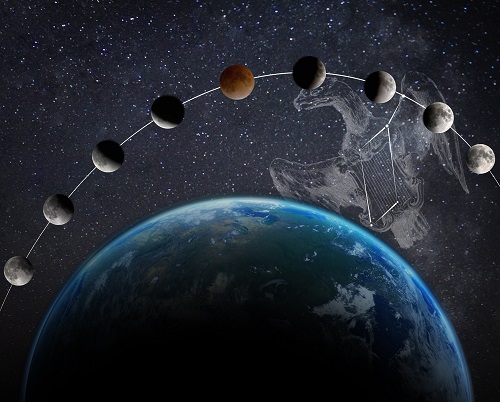Reach for the moon and stars, Skyline

Photo credit: Dave Newlands
If you weren’t encased in fog on Monday night, you might’ve been lucky enough to see the total lunar eclipse or “blood moon,” which was visible to most of the west coast from around 11 pm to 4 am. If you’re like most bay area residents, perhaps you noticed some pink clouds. However, there will be more opportunities for for stargazing coming up, and this Monday’s lunar eclipse was the first in a lunar tetrad, meaning there will be three more opportunities to see a lunar eclipse before the end of 2015.
Additionally, April 16 marks the beginning of the Lyrids meteor shower, which will be visible for eight days, peaking on April 22, according to earthsky.org. Lyrids is active every year in late April and will produce 10-20 meteors per hour at its peak. According to history instructor Michael Phipps, Lyrids is named for the constellation Lyra, which it originates from. Both words are derived from “lyre,” which is an ancient Greek harp, and makes sense when you look at Lyra’s shape. Gabe Prochter, who teaches observational astronomy, advised watching the meteor shower from somewhere dark and away from city lights, noting that if you can’t see most observable stars, you won’t be able to see most meteors.
Student Hannah Yamaura was unaware of the meteor shower, although she’d been alerted to Monday’s eclipse and missed it. She was excited to have another chance in October, though.
“I heard about it but forgot,” Yamaura said. “ I saw a solar eclipse in 2012, though.”
“The mind reels with the significance of both meteors and eclipses in history, and throughout cultures,” Phipps said over email. “Eclipses were also thought to presage important events, for instance there are records of lunar eclipses before the fall of Constantinople to the Turks in 1453, and the ancient writers Herodotus, Cicero, Pliny and Plutarch saw them as milestones in history, and there is even a reference in the Odyssey of Homer to one. The Babylonians, Egyptians, Mayans, and other cultures all had records, myths, and could even predict various eclipses at times.”
He added that some historical references to meteor showers include the Epic of Gilgamesh, the world’s oldest written epic, which mentions a massive meteor shower that destroys civilization, and that Rabbi bar Nachmani, 2000 years later, blamed a meteor shower for Noah’s flood. Comets, which meteor showers are derived from, have frequently been thought of as bad omens, and, according to Phipps, were predictors of the plague of 141 AD, the triumph of William the Conqueror in 1066 AD, and the destruction of Genghis Khan. He also noted that meteor showers have been referred to as “falling stars” by some cultures and thought to bring good luck.
According to Prochter, the wide visibility of total lunar eclipses is what has caused so many people’s fascination with them.
“These events are visible by all. That, by itself, makes them interesting,” He wrote in an email interview. “Also, they transform an object which seems constant into something other, which can scare people. For a long time people didn’t know what was going on during a (lunar) eclipse, the moon simply turned red. Scary.”
Prochter noted that the lunar tetrad and meteor showers have nothing to do with each other, since the meteor showers are annual and lunar tetrads appear roughly every 18 years.
Another meteor shower, Eta Aquarids, will be visible May 5 and is supposed to be somewhat more exciting than Lyrids, with possibly one visible meteor per minute, according to Sky and Telescope. The next opportunity to see a total lunar eclipse will be later this year on Oct. 8, when the weather will hopefully be more cooperative for viewing. There will also be other opportunities to see interesting things in the sky this year.
“Mars is up right now, so is Jupiter, “Prochter wrote. “Those are pretty cool. There are, of course, the other lunar eclipses and meteor showers, but really just seeing the planets of our solar system is cool enough. You’ll have to wait until summer to see Andromeda, a galaxy and the most distant object the human eye can see. Again you’ll have to be somewhere dark.”






